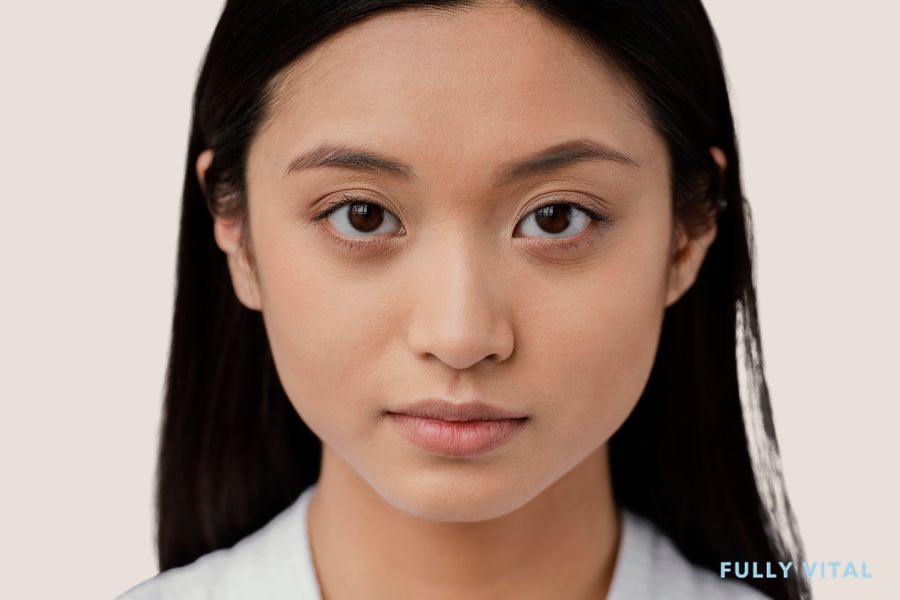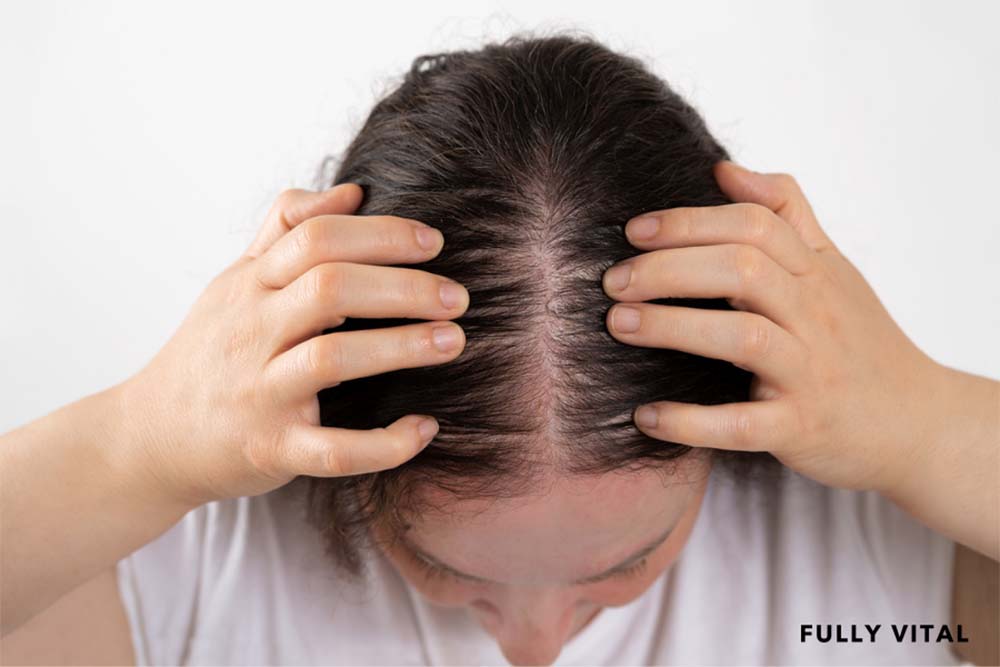
Low Hairlines: Understanding And Addressing Hairline Recession
Are you concerned about your low hairline and wondering how to address it effectively? You're not alone.
Many women, regardless of their hair type, seek ways to stimulate hair growth and improve the appearance of their hairlines.
In this article, we'll explore the ins and outs of low hairlines and how they can impact your confidence.
We'll also discuss solutions, benefits, potential downsides, and alternatives, and answer frequently asked questions about low hairlines.

I LOVE MY HAIR NOW
FullyVital hair serum and hair vitamins made tremendous improvements in my hair. I truly love my hair now.
Dorit S.,
What Is A Low Hairline?
A low hairline, also known as a hairline recession, refers to a condition where the hairline starts unusually low on the forehead, giving the appearance of a smaller forehead area.1

Why Is Awareness Of A Low Hairline Important?
For many women, hair serves as a significant part of their identity.
A low hairline can affect self-confidence and make some individuals feel self-conscious about their appearance.
Understanding the causes and available solutions for low hairlines is crucial to address this concern effectively.
How Does A Low Hairline Occur?
Hairline recession typically occurs due to a combination of genetic factors, hormonal changes, and aging.
Many women experience a receding hairline during menopause or postpartum, while others may be genetically predisposed to a low hairline.
Understanding the underlying causes can help identify appropriate treatment options.
How Can I Regrow My Frontal Hairline?
Regrowing a frontal hairline can be a gradual process that requires patience and consistent effort.
There is no magic solution or overnight fix, but here are some tips to help stimulate hair regrowth in the frontal hairline:
Use Hair Growth Products
Look for products that contain ingredients such as minoxidil, biotin, and keratin.
These ingredients have been shown to promote hair growth and may provide support in regrowing your frontal hairline.
Try Scalp Massage
Gently massaging your scalp with your fingertips can help increase blood circulation to the hair follicles, potentially aiding hair regrowth.
This can be done daily or a few times a week for a few minutes at a time.2
Maintain A Healthy Lifestyle
Eating a balanced diet rich in vitamins and minerals, managing stress levels, and avoiding excessive heat styling and chemical treatments can all contribute to overall hair health.
Providing your body with the necessary nutrients and reducing external stressors can support the regrowth of your frontal hairline.
Consult A Professional
If you're concerned about your frontal hairline and want personalized advice, it's advisable to consult a dermatologist or trichologist.
They can assess your specific situation, evaluate any underlying causes, and recommend appropriate treatments or procedures tailored to your needs.
What Are The Benefits Of Addressing Low Hairlines?
Addressing low hairlines not only enhances one's appearance but also boosts self-esteem and confidence.
By employing suitable hair growth products and treatments, women can stimulate hair regrowth and restore a more natural and desired hairline.
This can result in a positive impact on their overall well-being and quality of life.3
Is A Low Hairline Typically A Hereditary Trait?
A low hairline can indeed be genetic as it is often passed down through family members.
If your parents or close relatives, such as grandparents or siblings, have a low hairline, there is a higher chance that you may inherit this trait.
Genetic factors play a significant role in determining the characteristics of our hairline.
However, it's important to note that genetics is just one factor contributing to a low hairline, and other factors such as hormonal changes and aging can also play a role.
What Does It Mean When Your Hairline Is Less Defined?
When your hairline is less defined, it typically refers to a gradual recession of the hairline, resulting in a less prominent or receded hairline.
This can make the forehead appear larger and affect the overall balance of facial features.
Various factors can contribute to a less defined hairline, including genetics, hormonal changes, aging, or certain medical conditions.
It's important to address this concern if it bothers you, as there are methods and treatments available that can help restore a more defined and balanced appearance to your hairline.
Consulting with a dermatologist or trichologist can provide further insights and personalized recommendations.
At What Age Does The Hairline Start Thinning?
Hairline thinning can vary from person to person, but it often begins to occur in the late twenties or early thirties.
However, it's important to remember that individual experiences may differ.
Factors such as genetics, hormonal changes, and lifestyle choices can influence the onset of hairline thinning.
It's not uncommon for some individuals to experience hairline thinning at a younger age, while others may not experience it until later in life.
Monitoring changes in your hairline and seeking professional advice if you have concerns is always a good idea.
Does A Lower Hairline Make You Look Younger?
The impact of a lower hairline on one's appearance in terms of looking younger or older can vary depending on individual factors such as facial structure and personal preferences.
In some cases, a lower hairline can create a more youthful and harmonious look by framing the face and adding fullness to the forehead area.
However, it's important to keep in mind that beauty standards and perceptions of youthfulness can vary between cultures and individuals.
Ultimately, feeling confident and comfortable in your own unique features is what matters most.
If you have specific concerns or are interested in altering the appearance of your hairline, consulting with a professional can provide you with more information and options.
Unlock Timeless Beauty With Fully Vital!
Ready to turn back the clock on your hair? Start your journey to a more youthful you today! |
Final Thoughts On Low Hairlines
Low hairlines can significantly impact one's self-confidence and overall well-being.
Understanding the causes, treatment options, and historical significance of low hairlines is essential in addressing this concern effectively.
By embracing the knowledge and solutions available, women can take control of their hair growth journey and restore a more desirable and natural-looking hairline.
At Fully Vital, we strive to provide a range of hair growth products that promote healthy hair and empower women to embrace their unique beauty.
Our products are formulated to address the common concerns associated with low hairline, helping to stimulate hair regrowth and restore confidence.
Taking steps towards a healthier relationship with your hair is the first step towards embracing your natural beauty.
Frequently Asked Questions About Low Hairlines
Are there any natural remedies for a low hairline?
While individual results may vary, some natural remedies may help improve the appearance of a low hairline or overall hair health.
These remedies include:
- Scalp massage with essential oils like rosemary or lavender
- Maintaining a balanced diet rich in vitamins and minerals
- Using herbal supplements like saw palmetto or ginseng
- Trying essential oil blends with nourishing properties
Can a low hairline be a sign of a medical condition?
In some cases, a low hairline can be associated with an underlying medical condition.
Conditions such as androgenetic alopecia, certain autoimmune disorders, hormonal imbalances, and thyroid disorders may contribute to hairline recession.
If you suspect that your low hairline is related to a medical condition, it's important to consult a healthcare professional for proper evaluation and guidance.
Can low hairlines be considered a physical abnormality?
While a low hairline may be perceived as a physical abnormality by some, it is important to remember that everyone's hairline differs and should be celebrated as part of individual uniqueness.
However, if a low hairline is causing emotional distress or affects one's well-being, there are various treatment options available to address this concern and restore a desired hairline appearance.
Do low hairlines affect hair growth?
Having a low hairline does not directly affect hair growth itself.
Hair growth occurs within the follicles, which are located beneath the scalp.
A low hairline primarily affects the visual appearance of the hairline rather than the actual hair growth process.
However, factors like hormonal changes, genetics, and certain medical conditions associated with low hairlines may affect hair growth overall.
What conditions are associated with a low hairline?
Several conditions can be associated with a low hairline, including:
- Androgenetic alopecia (pattern hair loss)
- Certain autoimmune disorders
- Hormonal imbalances
- Thyroid disorders
- Trichotillomania (hair pulling disorder)
- Congenital conditions or birth defects affecting the hair and scalp
Does the hairline get higher with age?
In most cases, the hairline naturally recedes slightly as a part of the aging process.
This can give the appearance of a higher hairline, particularly along the temples and forehead.
However, the rate of hairline recession and its impact can vary significantly among individuals.
It's important to note that not everyone experiences significant hairline changes as they age.
Can hair products cause a low hairline?
Properly used hair products, such as shampoos, conditioners, and styling products, do not cause a low hairline.
However, certain styling techniques, such as tight hairstyles or excessive heat styling, can contribute to hair breakage and temporary hair loss.
It's important to handle and style your hair gently to maintain its health and minimize any potential damage.
Can stress cause a low hairline?
While stress can lead to temporary hair loss, also known as telogen effluvium, it is unlikely to directly cause a low hairline.
However, chronic stress and high levels of cortisol can negatively impact hair health and contribute to overall hair thinning.
Adopting stress-management techniques, maintaining a balanced lifestyle, and seeking professional help if needed can help mitigate the effects of stress on hair health.
How does hair transplantation work for a low hairline?
Hair transplantation is a surgical procedure that involves moving hair follicles from one part of the body (typically the back or sides of the scalp) to the area with a low hairline.
This procedure is often used for individuals looking to restore their hairline and achieve a more defined appearance.
It is crucial to consult with a qualified hair transplant specialist to discuss the suitability, process, and expected outcomes of hair transplantation.
Do hats or headbands contribute to a low hairline?
Wearing hats or headbands does not directly contribute to a low hairline.
However, certain hairstyles involving tight headbands or continuous friction from hats may lead to temporary hair breakage or traction alopecia.
To maintain healthy hair and minimize the risk of damage, it is advisable to choose headwear and hairstyles that do not put excessive pressure or strain on the hairline and scalp.
Sources:
- Receding hairline: Treatment, stages, and causes. (2018, January 8). Www.medicalnewstoday.com. https://www.medicalnewstoday.com/articles/320537
- Koyama, T., Kobayashi, K., Hama, T., Murakami, K., & Ogawa, R. (2016). Standardized Scalp Massage Results in Increased Hair Thickness by Inducing Stretching Forces to Dermal Papilla Cells in the Subcutaneous Tissue. Eplasty, 16. https://www.ncbi.nlm.nih.gov/pmc/articles/PMC4740347/
- Suchonwanit, P., Thammarucha, S., & Leerunyakul, K. (2019). Minoxidil and its use in hair disorders: a review. Drug Design, Development and Therapy, Volume 13, 2777–2786. https://doi.org/10.2147/dddt.s214907







